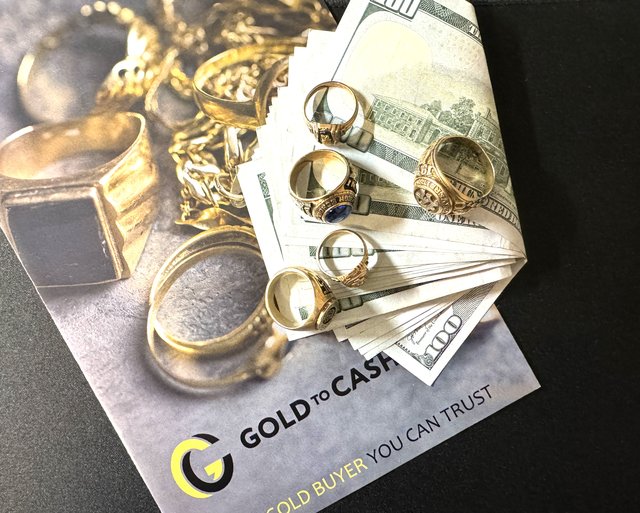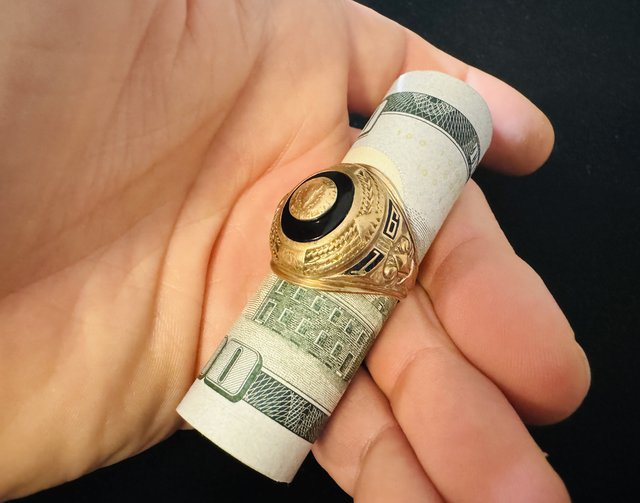You have several options for selling your gold class ring, but for the best payout, trust Gold to Cash. To begin the process, request your gold kit now. Additionally, you can determine the estimated value of your gold ring using our convenient gold calculator.
What is a Gold Class Ring?
A gold class ring is a type of ring typically worn by individuals to symbolize their affiliation with a particular school or college. These rings are commonly associated with academic achievements and are often personalized with the wearer's graduation year, school name, and sometimes other symbols or gemstones.
Gold class rings are traditionally made of gold, and the design can vary widely. They often feature the school's crest or logo, along with other elements that hold significance to the individual wearer. Class rings are often presented or purchased as a commemorative item during the wearer's high school or college years.
These rings not only serve as a symbol of academic accomplishment but also as a sentimental keepsake. Many people cherish their class rings as a reminder of their educational journey and the community they were a part of during those formative years. While gold is a common material for class rings, they can also be made from other metals, and the design possibilities are diverse.
Types of Class and Championship Rings We Purchase
When it comes to selling your class or championship ring, nearly all styles and sizes are accepted. Both traditional men's rings—often recognized for their bold, substantial appearance—and the more delicate, detailed designs frequently found in women's rings are welcome.
Most rings are crafted from gold, with 10k gold being particularly common due to its durability and everyday practicality. Occasionally, rings made from higher-purity gold or even platinum make an appearance, though these are much less frequent. It’s uncommon for genuine class or championship rings to be merely gold-filled or plated.
As for gemstones, while many rings feature stones, these are typically decorative and may have minimal inherent value compared to the precious metal content. Whether your ring features your school’s crest, sports achievements, or intricate custom details, its composition and craftsmanship are what generally matter most during the selling process.
Do Stones in Class Rings Have Value?
While gold class rings often feature stones—sometimes in vibrant colors or mimicking more precious gems—it’s important to know that these stones typically have little to no intrinsic value. Most commonly, the stones are synthetic or imitation, chosen for their appearance rather than rarity or worth. Exceptions exist, such as certain university rings or championship pieces that occasionally use higher-quality stones, but these are rare.
If you’re considering selling your ring, keep in mind that the bulk of the value lies in the gold itself, not the stone. The sentimental significance may be meaningful, but from a material standpoint, stones in class and championship rings usually don’t contribute much to the ring’s overall resale value. The main focus for buyers will be the weight and purity of the gold used in the ring’s band and setting.

Most Common Gold Class Ring Compositions
Gold class rings can come in various karats, representing the purity of the gold used in their construction. The most popular karats for gold class rings are typically 10k, 14k, and 18k. Here's a brief overview of each:
10k Gold:
- Composition: 10k gold is made up of 41.7% pure gold and 58.3% alloyed metals.
- Advantages: It is more durable and affordable than higher karat options. Its alloy content makes it less prone to scratching and wear, making it suitable for everyday wear.
14k Gold:
- Composition: 14k gold contains 58.3% pure gold and 41.7% alloyed metals.
- Advantages: A popular choice for class rings due to its balance between gold purity and durability. It offers a good compromise between richness of color, durability, and cost.
18k Gold:
- Composition: 18k gold is composed of 75% pure gold and 25% alloyed metals.
- Advantages: Known for its higher gold content, 18k gold has a richer color and is often considered more luxurious. However, it may be slightly softer than lower karat options.
The choice of karat for a gold class ring often depends on personal preference, budget, and desired durability. While 10k gold is the most popular choice for class rings, some individuals may opt for the higher purity of 14k or 18k gold for its richer color, while others may choose 10k gold for its durability and affordability. It's essential to consider factors such as wear and tear, maintenance, and the overall look you desire when selecting the karat for your gold class ring.
Are Class and Championship Rings Usually Gold-Filled or Plated?
Most class and championship rings are crafted from solid gold, primarily in 10k, 14k, or 18k varieties, rather than being gold-filled or plated. It's uncommon to find authentic school or championship rings that merely have a gold coating—solid gold construction is the standard, ensuring both durability and long-lasting value. However, while the gold content is genuine, the stones featured in these rings are usually synthetic or of minimal value, with exceptions being quite rare. If you're evaluating a class ring, you can typically expect real gold, but the gemstones are more likely to be decorative than precious.

Should I Sell My Gold Class Ring?
If you're still unsure whether you should sell your gold class ring or keep it, consider the following factors to make a balanced decision.
1. Sentimental Value:
- Consider the sentimental value attached to the ring. If it holds significant memories or represents a milestone, you may want to keep it a bit longer as a sentimental keepsake.
2. Financial Need:
- Assess your current financial situation. If you are in need of funds and the ring is not used too often, selling it could provide some financial relief.
3. Current Market Conditions:
- Stay informed about current gold prices and market conditions. Selling gold when prices are favorable can maximize your return.
4. Alternatives to Selling:
- Explore alternative options, such as repurposing the ring into a new piece of jewelry. This way, you can retain the sentimental value while giving the item a fresh purpose.
5. Future Use:
- Consider if there are future scenarios where you might appreciate having the ring, such as passing it down to family members or using it for another significant occasion.
6. Appraisal:
- Get the ring appraised by a professional to determine its current market value. This information can help you make an informed decision about selling.
7. Emotional Preparedness:
- Selling a sentimental item can be an emotional decision. Ensure you are emotionally prepared to part with the ring and that the potential financial gain aligns with your needs and values.
8. Gold Content and Karat:
- Understand the gold content and karat of the ring. Higher karat gold generally has a higher gold content but may be softer. Consider how these factors impact the ring's value and durability.
Before making any decisions, it's advisable to take your time, weigh the pros and cons, and perhaps consult with trusted friends, family, or financial advisors. Additionally, ensure that you choose a reputable buyer like Gold to Cash if you decide to sell, and be aware of the current market conditions to get the best value for your gold class ring.
Tips To Sell Your Gold Class Ring
Before selling, consider the following tips:
-
Get Appraisals: If the class ring has sentimental value, consider getting an estimate first. This way, you'll have an idea of its potential market value. One of the best tools use for an estimate is our gold calculator.
-
Research Market Prices: Understand the current market prices for gold to ensure you receive a fair offer. Gold prices can fluctuate, so staying informed is crucial.
-
Check Reviews: If using an online service, check reviews and ratings to ensure the legitimacy and reliability of the buyer.
-
Understand Terms and Conditions: Whether selling online or in person, be sure to understand the terms and conditions, including fees and the payment process.
How Do Our Offers for Jewelry Compare to Other Buyers?
When selling your gold class ring or other jewelry, it's natural to shop around for the best possible return. Many sellers find that our offers are often more competitive than what is typically quoted at local pawn shops or national jewelry chains.
- Higher Payouts: We've heard from customers who were pleasantly surprised to receive more for their items here than they expected based on quotes from other buyers. Some even report getting significantly higher payouts than at well-known online services or high street gold buyers.
- Transparent Valuation: Our process is straightforward and professional, focusing on offering true value—no hidden fees or ambiguous estimates.
- Customer Experiences: Several individuals mention that, while the interaction is professional and businesslike, the real standout is the final amount received—consistently beating offers from major competitors, including big names like Cash4Gold and local jewelry stores.
By comparing offers from a few different places before making your final decision, you’ll see for yourself how our payouts often come out ahead. This helps ensure you feel confident that you’re maximizing your return when you choose to sell your gold class ring or jewelry with us.
Customer Experiences When Selling Jewelry, Scrap Gold, and Silver
Hearing from others who have gone through the process can bring some peace of mind if you're thinking about selling your jewelry, scrap gold, or silver. Many people report being pleasantly surprised by their experiences. Here are some common themes we've heard:
-
Better Than Expected Offers: A number of sellers mention receiving more than they anticipated—sometimes even above what they were quoted elsewhere. It's not uncommon for customers to walk in with modest expectations and leave with a payout that exceeds what local pawn shops or national chain stores like Cash America or Kay Jewelers offered.
-
Professionalism and Transparency: Sellers often highlight how knowledgeable and straightforward the staff were during the evaluation process. Even if the experience felt all business, the professionalism and honesty were generally appreciated, with clear explanations about how the items were valued.
-
Welcoming Atmosphere: While some buyers can seem focused on the task at hand, others take the time to answer questions and walk you through the valuation—helpful if you're new to buying or selling precious metals. Many people appreciate having their options explained and the process demystified along the way.
-
Positive Recommendations: After selling their jewelry or silver, customers commonly recommend the service to friends or family, especially those who had experiences at competitors like Gold Guys or regional jewelers that didn’t match up in terms of offer or clarity.
-
Success With a Variety of Items: Whether it’s dated dinnerware, scrap gold, sterling flatware, or old jewelry from the back of a drawer, people found that even things they considered “junk” could fetch a worthwhile offer.
These firsthand experiences show that doing a bit of research and finding a reputable, professional buyer can turn your once-forgotten jewelry or silverware into real value—often to a pleasantly surprising degree.
Now, that you have all the information and you are ready to proceed with the sale, request an appraisal kit to get started. If you still have questions please feel free to contact us. Also, consider viewing our recent payouts to get an idea on what we pay.